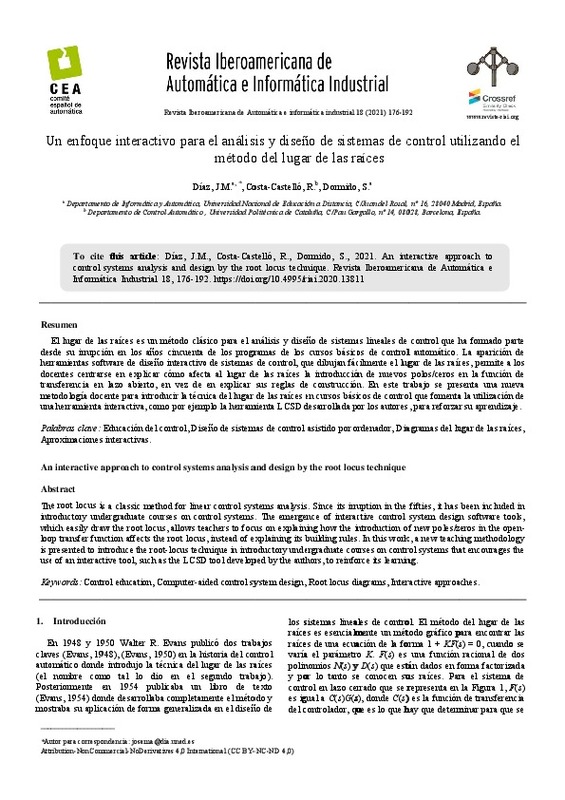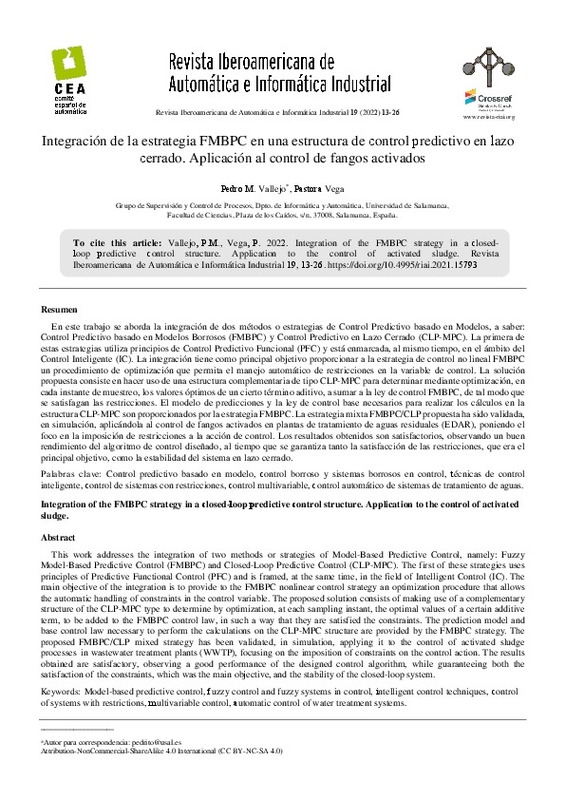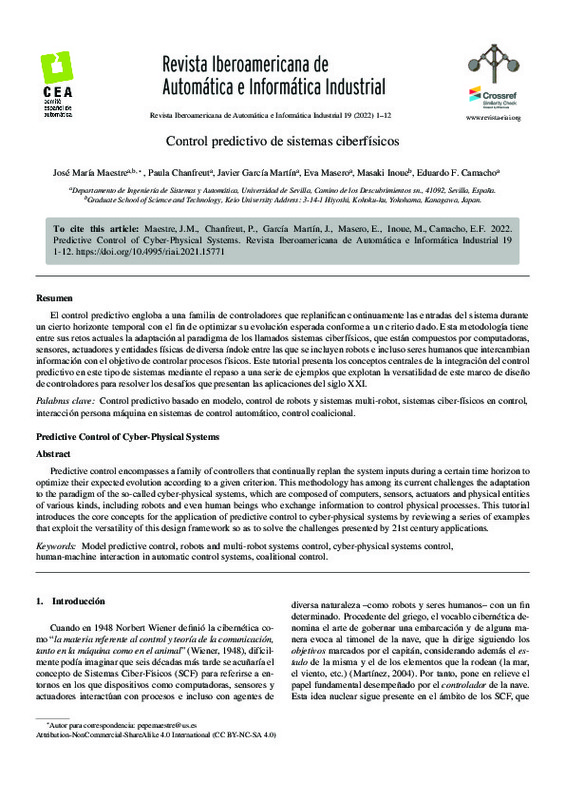JavaScript is disabled for your browser. Some features of this site may not work without it.
Buscar en RiuNet
Listar
Mi cuenta
Estadísticas
Ayuda RiuNet
Admin. UPV
Un enfoque interactivo para el análisis y diseño de sistemas de control utilizando el método del lugar de las raíces
Mostrar el registro sencillo del ítem
Ficheros en el ítem
| dc.contributor.author | Díaz, J. M.
|
es_ES |
| dc.contributor.author | Costa-Castelló, R.
|
es_ES |
| dc.contributor.author | Dormido, S.
|
es_ES |
| dc.date.accessioned | 2021-04-15T10:30:59Z | |
| dc.date.available | 2021-04-15T10:30:59Z | |
| dc.date.issued | 2021-04-06 | |
| dc.identifier.issn | 1697-7912 | |
| dc.identifier.uri | http://hdl.handle.net/10251/165205 | |
| dc.description.abstract | [EN] The root locus is a classic method for linear control systems analysis. Since its interruption in the fifties, it has been included in introductory undergraduate courses on control systems. The emergence of interactive control system design software tools, which easily draw the root locus, allows teachers to focus on explaining how the introduction of new poles/zeros in the openloop transfer function affects the root locus, instead of explaining its building rules. In this work, a new teaching methodology in presented to introduce the root locus technique in introductory courses on control systems that encourages the use of an interactive tool, such as the LCSD tool developed by the authors, to reinforce their learning. | es_ES |
| dc.description.abstract | [ES] El lugar de las raíces es un método clásico para el análisis y diseño de sistemas lineales de control que ha formado parte desde su irrupción en los años cincuenta de los programas de los cursos básicos de control automático. La aparición de herramientas software de diseño interactivo de sistemas de control, que dibujan fácilmente el lugar de las raíces, permite a los docentes centrarse en explicar cómo afecta al lugar de las raíces la introducción de nuevos polos/ceros en la función de transferencia en lazo abierto, en vez de en explicar sus reglas de construcción. En este trabajo se presenta una nueva metodología docente para introducir la técnica del lugar de las raíces en cursos básicos de control que fomenta la utilización de una herramienta interactiva, como por ejemplo la herramienta LCSD desarrollada por los autores, para reforzar su aprendizaje. | es_ES |
| dc.description.sponsorship | Este trabajo ha sido financiado por el Ministerio de Ciencia, Innovación y Universidades bajo los proyectos ECoDiC ref. RTI2018-094665-B-I00 y DOVELAR ref. RTI2018-096001-B-C32. | es_ES |
| dc.language | Español | es_ES |
| dc.publisher | Universitat Politècnica de València | es_ES |
| dc.relation.ispartof | Revista Iberoamericana de Automática e Informática industrial | es_ES |
| dc.rights | Reconocimiento - No comercial - Compartir igual (by-nc-sa) | es_ES |
| dc.subject | Control education | es_ES |
| dc.subject | Computer-aided control system design | es_ES |
| dc.subject | Root locus diagrams | es_ES |
| dc.subject | Interactive approaches | es_ES |
| dc.subject | Educación del control | es_ES |
| dc.subject | Diseño de sistemas de control asistido por ordenador | es_ES |
| dc.subject | Diagramas del lugar de las raíces | es_ES |
| dc.subject | Aproximaciones interactivas | es_ES |
| dc.title | Un enfoque interactivo para el análisis y diseño de sistemas de control utilizando el método del lugar de las raíces | es_ES |
| dc.title.alternative | An interactive approach to control systems analysis and design by the root locus technique | es_ES |
| dc.type | Artículo | es_ES |
| dc.identifier.doi | 10.4995/riai.2020.13811 | |
| dc.relation.projectID | info:eu-repo/grantAgreement/AEI/Plan Estatal de Investigación Científica y Técnica y de Innovación 2017-2020/RTI2018-094665-B-I00/ES/DISEÑO EFICIENTE Y CONTROL DISTRIBUIDO DE SISTEMAS CIBER-FISICOS/ | es_ES |
| dc.relation.projectID | info:eu-repo/grantAgreement/AEI/Plan Estatal de Investigación Científica y Técnica y de Innovación 2017-2020/RTI2018-096001-B-C32/ES/CONTROL Y GESTION DE ENERGIA EN VEHICULOS ELECTRICOS HIBRIDOS CON PILAS DE COMBUSTIBLE/ | es_ES |
| dc.rights.accessRights | Abierto | es_ES |
| dc.description.bibliographicCitation | Díaz, JM.; Costa-Castelló, R.; Dormido, S. (2021). Un enfoque interactivo para el análisis y diseño de sistemas de control utilizando el método del lugar de las raíces. Revista Iberoamericana de Automática e Informática industrial. 18(2):176-192. https://doi.org/10.4995/riai.2020.13811 | es_ES |
| dc.description.accrualMethod | OJS | es_ES |
| dc.relation.publisherversion | https://doi.org/10.4995/riai.2020.13811 | es_ES |
| dc.description.upvformatpinicio | 176 | es_ES |
| dc.description.upvformatpfin | 192 | es_ES |
| dc.type.version | info:eu-repo/semantics/publishedVersion | es_ES |
| dc.description.volume | 18 | es_ES |
| dc.description.issue | 2 | es_ES |
| dc.identifier.eissn | 1697-7920 | |
| dc.relation.pasarela | OJS\13811 | es_ES |
| dc.contributor.funder | Agencia Estatal de Investigación | es_ES |
| dc.description.references | Arévalo, V., Vicente-del-Rey, J.M., García-Morales, I., Rivas-Blanco, I., 2020. Minivídeos tutoriales como apoyo al aprendizaje de conceptos básicos para un curso de Fundamentos de Control Automático. Revista Iberoamericana de Automática e Informática Industrial, 17, 107-115. https://doi.org/10.4995/riai.2020.12156 | es_ES |
| dc.description.references | Åström, K. J., Murray, R. M., 2014. Feedback Systems: An Introduction for Scientists and Engineers 2 nd Edition. Princeton University Press. | es_ES |
| dc.description.references | Díaz, J. M., Dormido, S., Aranda, J., 2007. SISOQFTIT: An interactive software tool for robust control design using the QFT methodology, Int. J. Eng. Educ., 23, 5, 1011-1023. | es_ES |
| dc.description.references | Díaz, J. M., Dormido, S., Rivera, D.E., 2016. ITTSAE: A set of interactive software tools for time series analysis education, IEEE Control Syst. Mag., 36, 3, 112-120. https://doi.org/10.1109/MCS.2016.2535914 | es_ES |
| dc.description.references | Díaz, J. M., Costa, R., Muñoz, R., Dormido, S., 2017. An interactive and comprehensive software tool to promote active learning in the loop shaping control system design. IEEE Access 5, 10533-10546. https://doi.org/10.1109/ACCESS.2017.2712520 | es_ES |
| dc.description.references | Dorf, R. C., Bishop, R. H., 2011. Modern Control Systems 12 th Edition. Prentice Hall. | es_ES |
| dc.description.references | Dormido, S., Gordillo, F., Dormido-Canto, S., Aracil, J., 2002. An interactive tool for introductory nonlinear control systems education, Proc. IFAC 15th World Congress, 35, 1, 255-260. https://doi.org/10.3182/20020721-6-ES-1901.01433 | es_ES |
| dc.description.references | Dormido, S., 2004. Control learning: Present and future, Annu. Rev. Control, 28, 1, 115-136. https://doi.org/10.1016/j.arcontrol.2003.12.002 | es_ES |
| dc.description.references | Dormido, S., Dormido-Canto, S., Dormido-Canto, R., Sánchez, J., Duro, N., 2005. The role of interactivity in control learning,Int. J. Eng. Educ., 21, 6, 1122-1133. | es_ES |
| dc.description.references | Evans, W. R., 1948. Graphical analysis of control systems. Transactions of the American Institute of Electrical Engineers 67, 547-551. https://doi.org/10.1109/T-AIEE.1948.5059708 | es_ES |
| dc.description.references | Evans, W. R., 1950. Control systems synthesis by root-locus method Transactions of the American Institute of Electrical Engineers 69, 66-69. https://doi.org/10.1109/T-AIEE.1950.5060121 | es_ES |
| dc.description.references | Evans, W. R., 1954. Control System Dynamics. McGraw-Hill, New York. | es_ES |
| dc.description.references | Franklin, G. F., Powell, J. D., Emami-Naeini, A., 2015. Feedback Control of Dynamic Systems 7 th Edition. Pearson. | es_ES |
| dc.description.references | Gasmi, H., Bouras, A., 2018. Ontology-based education/industry collaboration system, IEEE Access, 6, 1362-1371. https://doi.org/10.1109/ACCESS.2017.2778879 | es_ES |
| dc.description.references | Golnaraghi, F., Kuo, B. C., 2017. Automatic Control Systems 10 th Edition. McGraw-Hill. | es_ES |
| dc.description.references | Guzmán, J. L., Åström, K. J., Dormido, S., Hagglund, T., Berenguel, M., Piguet, Y., 2008. Interactive learning modules for PID control,IFAC Proc. 39, 6, 7-12. https://doi.org/10.3182/20060621-3-ES-2905.00003 | es_ES |
| dc.description.references | Guzmán, J. L., Rivera, D. E., Dormido, S., Berenguel, M., 2012. An interactive software tool for system identification, Adv. Eng. Softw., 45, 115-123. https://doi.org/10.1016/j.advengsoft.2011.09.013 | es_ES |
| dc.description.references | Guzmán, J. L., Dormido, S., Berenguel, M., 2013. Interactivity in education: An experience in the automatic control field, Comput. Appl. Eng. Educ., 21, 2, 360-371. https://doi.org/10.1002/cae.20480 | es_ES |
| dc.description.references | Guzmán, J. L., Costa, R., Dormido, S., Berenguel, M., 2016. An interactivity based methodology as support to control education, IEEE Control Syst. Mag., 35, 1, 11-25. | es_ES |
| dc.description.references | Keviczky, L., Bars, R., Hetthéssy, J., Bányász, C., 2019. Control Engineering. Springer. https://doi.org/10.1007/978-981-10-8297-9 | es_ES |
| dc.description.references | Lerma, E., Costa-Castelló, R., Griño Cubero, R., Sanchis, C., 2020. Herramientas para la docencia de control digital en grados de ingeniería, Revista Iberoamericana de Automática e Informática Industrial. [Online] https://polipapers.upv.es/index.php/RIAI/article/view/13756 | es_ES |
| dc.description.references | Moon, Y. L., 2007. Education reform and competency-based education, Asia Pacific Education Review, 8, 2, 337-341. https://doi.org/10.1007/BF03029267 | es_ES |
| dc.description.references | Nickerson, J. V., Corter, J. E., Esche, S. K., Chassapis, C., 2007. A model for evaluating the effectiveness of remote engineering laboratories and simulations in education, Computers & Education, 49, 3, 708- 725. https://doi.org/10.1016/j.compedu.2005.11.019 | es_ES |
| dc.description.references | Kasser, J., Hitchins, D., Frank, M., Zhao, Y. Y., 2013. A framework for benchmarking competency assessment models, Systems Engineering, 16, 1, 29-44. https://doi.org/10.1002/sys.21217 | es_ES |
| dc.description.references | Heradio, R., de la Torre, L., Dormido, S., 2016. Virtual and remote labs in control education: A survey, Annual Reviews in Control, 42, 1-10. https://doi.org/10.1016/j.arcontrol.2016.08.001 | es_ES |
| dc.description.references | Nise, N. S., 2015. Control Systems Engineering 7 th Edition. John Wiley and Sons. | es_ES |
| dc.description.references | Ogata, K., 2010. Modern Control Engineering 5 th Edition. Prentice Hall. | es_ES |
| dc.description.references | Piguet, Y., 2017. Sysquake 6 User Manual. Calerga, Lausanne. | es_ES |
| dc.description.references | Vargas, H., Heradio, R., Chacon, J., de La Torre, L., Farias, G., Galan, D., Dormido, S., 2019. Automated Assessment and Monitoring Support for Competency-Based Courses, IEEE Access, 7, 41043-41051. https://doi.org/10.1109/ACCESS.2019.2908160 | es_ES |
| dc.description.references | Vargas, H., Marín, L., de la Torre, L., Heradio, R., Díaz, J. M., Dormido, S., 2020. Evidence-based control engineering education: evaluating theLCSD simulation tool, IEEE Access, 8, 170183-170194, 2020 https://doi.org/10.1109/ACCESS.2020.3023910 | es_ES |











